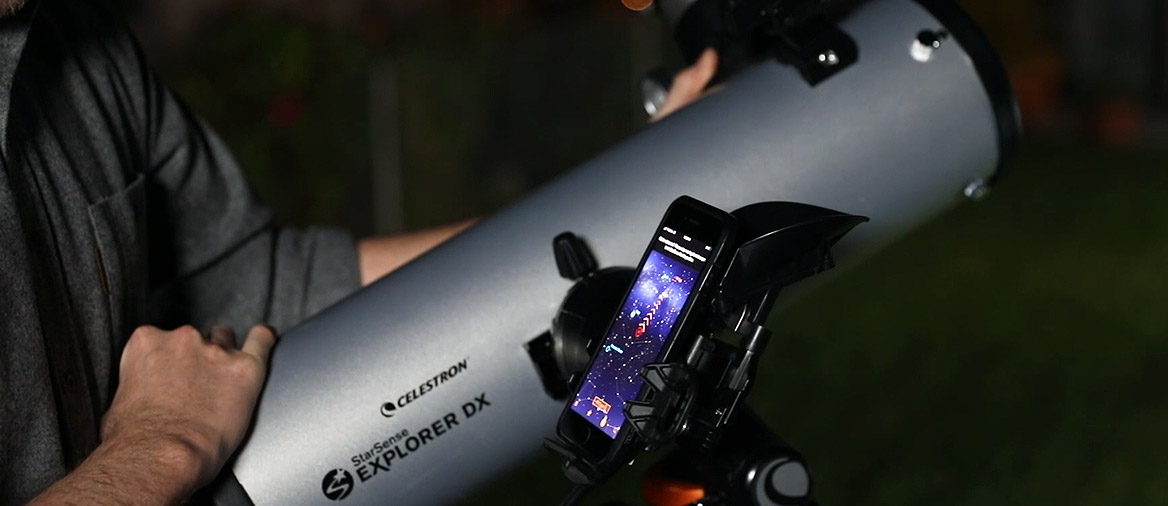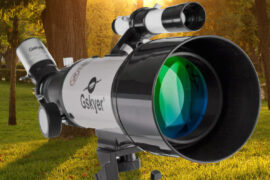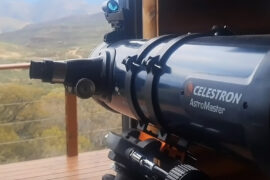There is one problem no one tells you about when you are looking to buy your first telescope and you imagine yourself simply pointing it at the sky and enjoying the view. Finding a specific object in the sky can be quite hard.
Unless it is an object that is visible to the naked eye like Mars, Jupiter, or the Moon, you can’t just point a telescope at a random spot and expect to find something. It turns out, space is quite big, and there’s a whole lot of nothing out there.
So that presents a problem. How do you actually go about finding nearby galaxies, nebulae, and planets to observe?
Well, this is the part that used to frustrate a lot of new stargazers. In order to find an object consistently you had to learn to “star-hop” which means using other visible stars as reference points to try and estimate the position of the object that you wanted to see. The problem is that method fell apart if said object wasn’t close to a reference point that was easy to recognize and was very hit-and-miss.
Another method was to look up and use the right ascension and declination of the object and point the mount to those coordinates. This is a more precise method but is only available to people with Equatorial mounts and can take a long time to set up.
Thankfully modern telescopes are starting to catch up and are trying to figure out solutions to this problem. This is where the Celestron Starsense models come in.
The distinguishing feature of the Starsense line is its direct integration with star-mapping technology that allows you to quickly find any object that is visible in the sky that night quickly and painlessly.
The Celestron Starsense DX 102AZ is the largest refracting model and in this article, I’ll go in-depth about my impressions after testing it and comparing it to similar models from other brands. Is it worth the money? Is it a good beginner telescope? Let’s answer all those questions.
The verdict
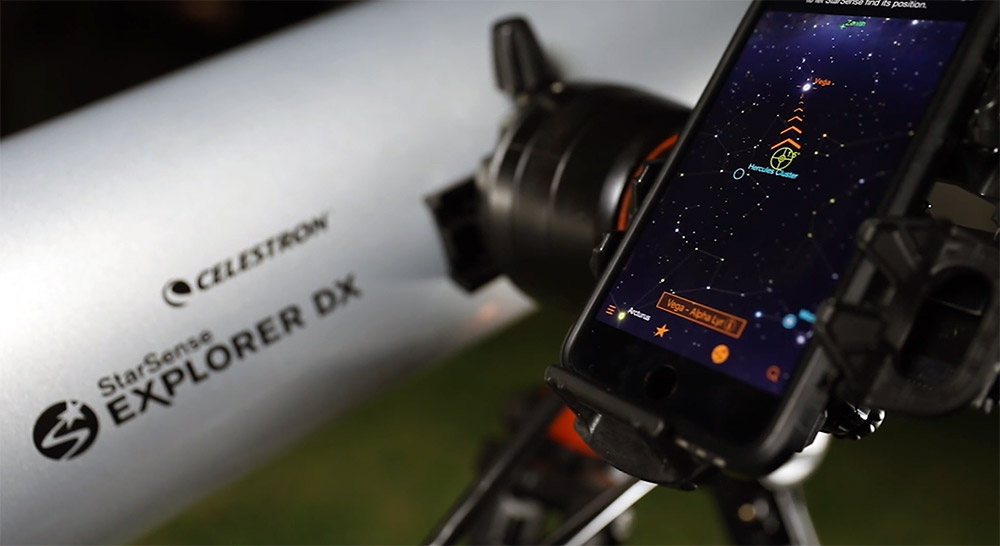
If you are in a hurry, here’s the quick verdict. If you want to know how I got to those conclusions, the full review with all the details is below.
The Celestron Starsense DX 102AZ and its smaller brother, the LT 80AZ are currently my top recommendation for anyone that is about to get their first telescope. Especially if it is a gift for a kid, a teenager, or if you are looking for a device that is simply “point-and-shoot”.
There’s probably no other good telescope on the market that is easier to use and still offers reasonable power. Being a refracting telescope, it does not need constant maintenance or mirror alignment. The Alt-Azimuth mount makes it very intuitive to control, and the star mapping functionality makes stargazing a great experience for beginners.
The optic quality is good although not spectacular. The images are sharp and have high contrast. I was able to notice some chromatic and spherical errors but that’s to be expected from a refracting model.
At 102 millimeters, the aperture of the lenses is pretty much the largest size you will find for a “point-and-shoot” telescope. The magnification this can reach is good enough to look at all the planets, and many of the brighter galaxies, and other deep-sky objects.
The build quality is solid and both the mount and the tripod are sturdier than on the 80mm model which is necessary to handle the extra weight.
While the Starsense DX 102AZ is definitely pricier than other telescopes of the same size, that difference in price is for the “Starsense” technology and the app that is included (there are no subscriptions or any hidden additional fees) and it is well worth it in my opinion.
Ratings
| Optics | 9 |
| Build quality | 8 |
| Ease of use | 10 |
| Portability | 8 |
| Innovation | 10 |
| Accessories | 6 |
| Price |
Technical specifications
| Model name | StarSense DX 102AZ |
| Manufacturer | Celestron |
| Telescope type | Refractor |
| Aperture | 102 mm (4″) |
| Focal length | 660 mm (26″) |
| Focal ratio | f/6.5 |
| Assembled Weight | 14.2 lb (6.4 Kg) |
| Eyepiece slot | 1.25″ |
| Maximum magnification | 240x |
| Limiting magnitude | 12.5 |
| Included eyepieces | Kellner 25mm, Kellner 10mm |
| Tripod | Aluminum |
| Mount | Altazimuth |
| Other included accessories | Mount, red dot finder, star diagonal, smartphone dock |
Review
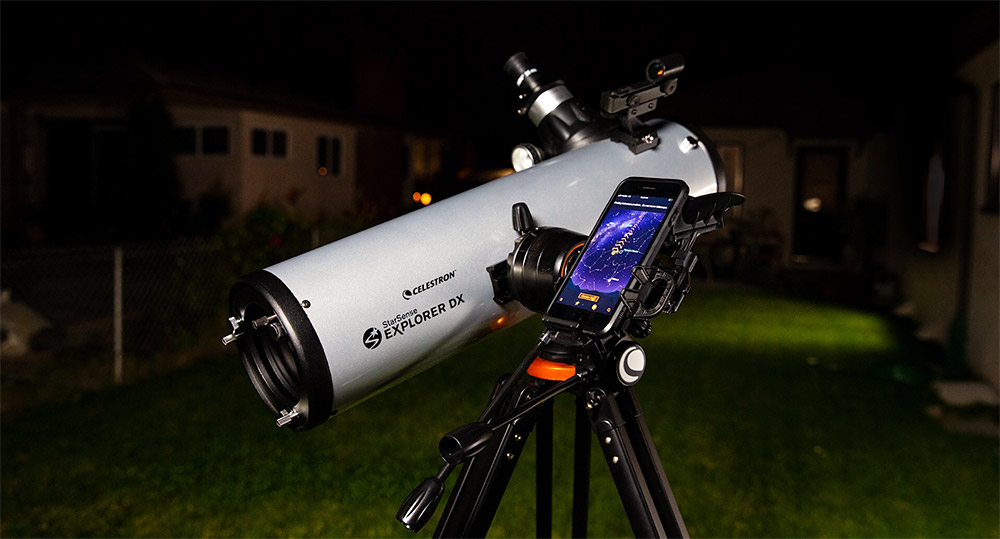
Let’s start by explaining the Starsense DX 102AZ specifications
First and most importantly, as its name implies, it has an aperture of 102 millimeters (4 inches). This is very generous for a refracting telescope because manufacturing lenses in larger sizes gets very expensive (larger telescopes use mirrors as a replacement).
An aperture of 102mm is going to allow you to comfortably see all the major geological features of the Moon and all of its major craters. Mars and Jupiter can be seen with some minor detail and with some good conditions you should be able to see some features like Mars’ poles. Saturn and its rings are clearly visible although you won’t get much detail out of them. Mercury and Venus are visible but they can be tricky to observe even with high-end telescopes due to them being positioned in the direction of the Sun. Uranus and Neptune will just look like blue dots as they are too far away.
This telescope can see objects with a magnitude (brightness) below 12.5, which includes dozens of the most commonly known galaxies like Andromeda, the Sombrero Galaxy, and Bode’s Galaxy. Some major nebulas and star clusters can also be observed. For a more detailed guide on what you will be able to see, including photos, check out this guide about what to expect from a 100mm telescope.
The focal length of this telescope is relatively short at only 660mm (26″). This seems a bit strange considering that the 80mm model has a focal length of 900mm. As a result, the DX 102AZ becomes a little more optimal for deep-space viewing (galaxies, nebulae, etc) and a better option if you want to try to do astrophotography with it as it becomes “faster”. The tradeoff is that planetary viewing gets slightly less convenient because it reduces the field of view.
The quality of the lenses is very high as you might expect from a Celestron product. The resolved images are sharp and have good contrast even while using just the bundled eyepieces. As with any refracting telescope, you will find certain color and spherical errors if you look for them, but that’s because all refractors do that, the question is how notorious is this effect, and in the case of the Starsense DX 102AZ Celestron has done a good job minimizing it.
If you are a bit confused at this point about what I mean by a refracting telescope, that is the type or the design of the telescope. Check out our post about the pros and cons of refracting telescopes to learn more and see if these are good for you.
The bundled mount is a variant of an Alt-Azimuth mount with some modifications made to put the smartphone dock on the side. This is the type of mount I recommend to beginners as it is basically “point and shoot” and the control is easy to use.
But the main feature of this telescope is really the Starsense technology. It works by attaching the phone to the dock and firing up the app (the app is included with your purchase and doesn’t require any extra fees or subscriptions). To get started you need to point the telescope to an area where it can capture at least 3 stars so the app can figure out your position and start to map out the sky.
Once the telescope is aligned you will able to see the image the lens is capturing through the phone (although you can also simply look through the eyepiece like in a regular telescope). The app automatically adds labels with the names of the stars, planets, and constellations you are looking at. You can also open up the database and search for a specific object. The Starsense app will tell you if it is visible at that moment and if so, it will show directions on the screen so you can point the telescope towards that object.
Even as an experienced astronomer that knows the sky quite well, the Starsense technology makes things so easy to find that I believe in the future all telescopes will come with some version of this functionality.
The biggest question about the Celestron Starsense DX 102AZ is its price. Compared for example to the Orion Starblast 102mm, which is a model with almost identical specifications and quality but that doesn’t come with the Starsense technology, the Starsense is usually priced 20%-30% higher. Whether that is a lot or not is going to depend on you and your budget but I consider the star mapping functionality to be worth the extra cost.
The thing I don’t like at all about this telescope is the bundled accessories. It comes with two Kellner eyepieces (25mm and 10mm). This is pretty standard for 70mm-90mm models and they are serviceable but the telescope has enough power to benefit from using more premium eyepieces. It is not necessary that you upgrade right away, but eventually, I’d recommend upgrading to at least Plossl eyepieces.
Likewise, the telescope doesn’t come bundled with a Barlow Lens. This is an accessory that connects to any eyepiece and can multiply its magnification. That means that if you own one Barlow and 3 eyepieces, it would be like effectively having 6 eyepieces with different levels of magnification. It is a bit weird that with the more premium feel of the DX 102mm even a basic Barlow is not included.
If you do decide to upgrade the accessories now or in the future, check out our post with our telescope eyepiece kits recommendations so you can save by buying them in a bundle, most of them also include a Barlow lens. If you don’t want to do that at the moment, I would recommend at least getting a basic 2X Barlow like the Celestron Omni 2X so you can pair it with the bundled 10mm eyepiece to get close to the maximum supported magnification the telescope can reach. The Starsense DX 102AZ can reach a maximum magnification of 240x which means it supports eyepieces of up to 3mm (the smaller the eyepiece the more magnification you get from it). With the 10mm eyepiece and a 2X Barlow, you would get close as it would be like using a 5mm eyepiece.
In general, the Celestron Starsense DX 102AZ is a great pick in the following cases:
- A first telescope for a kid or teenager
- An upgrade from a 70mm-80mm telescope
- If you are looking for a portable, lightweight telescope for travel
- For an adult looking for an easy-to-use telescope that doesn’t require maintenance
If you are an adult and you’d prefer to get more power and you don’t mind a steeper learning curve and a heavier setup, I’d recommend checking out the 130mm Newtonian model instead.
If your use case fits into the ones listed above, you or whoever you gift this to will have a great time. As I mentioned at the beginning of the article, the Starsense telescopes are my current go-to recommendation for beginners. This is the model I’d get for a niece or a friend that is looking to get into stargazing, and while it is not perfect and it is a little bit on the expensive side, I believe it is one of the best options on the market.

